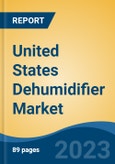Speak directly to the analyst to clarify any post sales queries you may have.
10% Free customizationThis report comes with 10% free customization, enabling you to add data that meets your specific business needs.
United States Dehumidifier Market was valued at USD 956.44 million in 2024 and is anticipated to grow USD 1.39 billion by 2030 with a CAGR of 6.54% during forecast period. The United States dehumidifier market is experiencing steady growth, driven by increasing awareness of indoor air quality, rising humidity levels, and expanding applications across residential, commercial, and industrial sectors. Consumers are increasingly investing in dehumidifiers to combat health issues like asthma and allergies, particularly in humid regions such as the southern and coastal states. Technological advancements have led to more energy-efficient and user-friendly models, featuring intelligent controls and programmable settings. The residential segment remains a significant contributor, while commercial and industrial applications in offices, hospitals, and data centers are also expanding.
Key Market Drivers
Rising Awareness of Indoor Air Quality and Health Impacts
One of the most significant drivers of the U.S. dehumidifier market is the increasing public awareness regarding the importance of indoor air quality. Dehumidifiers play a critical role in reducing excess moisture, which helps prevent the growth of mold, mildew, and dust mites - common indoor allergens linked to respiratory issues such as asthma, bronchitis, and allergic rhinitis.As people become more health-conscious, there's growing demand for home appliances that contribute to a safer and healthier living environment. Americans, on average, spend nearly 90% of their time indoors, where indoor air quality can significantly impact health and well-being. In fact, the concentration of certain pollutants inside homes and buildings is often 2 to 5 times higher than typical outdoor levels. This heightened exposure to indoor contaminants - such as mold spores, dust mites, and volatile organic compounds - is further exacerbated by excess humidity, which drivers the market dehumidifier market in the United States.
This awareness is further bolstered by information campaigns from health organizations and environmental agencies. The U.S. Environmental Protection Agency (EPA) and Centers for Disease Control and Prevention (CDC) regularly emphasize the link between high humidity levels and indoor air pollution. Consequently, homeowners, landlords, and facility managers are increasingly turning to dehumidifiers to create healthier spaces, especially in basements, bathrooms, and other moisture-prone areas.
Key Market Challenges
High Initial and Maintenance Costs
Despite the increasing demand for dehumidifiers, high upfront and maintenance costs remain a significant barrier to widespread adoption, especially among price-sensitive consumers. Advanced dehumidifier models with smart features, energy-efficient components, and large moisture-removal capacities can be relatively expensive. For households or small businesses with limited budgets, the cost of purchasing and installing these units may deter investment, especially when additional components like drainage systems or ductwork modifications are required.Furthermore, ongoing maintenance expenses such as filter replacements, coil cleaning, and energy consumption can add to the total cost of ownership. In regions with high humidity, units may operate for extended periods, increasing electricity usage and contributing to higher utility bills. Commercial and industrial users also face increased service costs to maintain optimal performance. These cost concerns can hinder growth in certain market segments, particularly in low- to middle-income residential areas and small enterprises.
Key Market Trends
Technological Advancements and Product Innovation
Technological innovation is another crucial driver transforming the United States dehumidifier market. Manufacturers are investing in R&D to deliver smarter, more energy-efficient, and environmentally friendly units. Key advancements include the integration of Internet of Things (IoT) capabilities, allowing users to monitor and control humidity levels remotely via smartphones or home automation systems.Modern dehumidifiers also feature improved refrigerants with low Global Warming Potential (GWP), energy-saving compressors, and noise-reduction technology. These innovations not only improve performance but also align with increasing consumer preferences for sustainable and quiet home appliances. ENERGY STAR certifications have become a key consideration for buyers, as consumers look to reduce their carbon footprints and energy bills.
Key Market Players
- Electrolux Home Products, Inc. (Frigidaire)
- Haier Group Corporation (GE Appliances)
- Honeywell International Inc.
- Four Seasons Trading Company, LLC (Keystone)
- Danby Products Inc.
- Unison Comfort Technologies
- Seresco Technologies Inc.
- Desert Aire Corp.
- Munters Corporation
- DecTron LLC
Report Scope:
In this report, the United States Dehumidifier Market has been segmented into the following categories, in addition to the industry trends which have also been detailed below.United States Dehumidifier Market, By Type:
- Desiccant
- Refrigerant
- Others
United States Dehumidifier Market, By End Use:
- Residential
- Commercial/Industrial
United States Dehumidifier Market, By Region:
- South
- West
- Midwest
- Northeast
Competitive Landscape
Company Profiles: Detailed analysis of the major companies present in the United States Dehumidifier Market.Available Customizations:
With the given market data, the publisher offers customizations according to a company's specific needs. The following customization options are available for the report.Company Information
- Detailed analysis and profiling of additional market players (up to five).
This product will be delivered within 1-3 business days.
Table of Contents
Companies Mentioned
- Electrolux Home Products, Inc. (Frigidaire)
- Haier Group Corporation (GE Appliances)
- Honeywell International Inc.
- Four Seasons Trading Company, LLC (Keystone)
- Danby Products Inc.
- Unison Comfort Technologies
- Seresco Technologies Inc.
- Desert Aire Corp.
- Munters Corporation
- DecTron LLC
Table Information
| Report Attribute | Details |
|---|---|
| No. of Pages | 81 |
| Published | April 2025 |
| Forecast Period | 2024 - 2030 |
| Estimated Market Value ( USD | $ 0.96 Billion |
| Forecasted Market Value ( USD | $ 1.39 Billion |
| Compound Annual Growth Rate | 6.5% |
| Regions Covered | United States |
| No. of Companies Mentioned | 10 |









